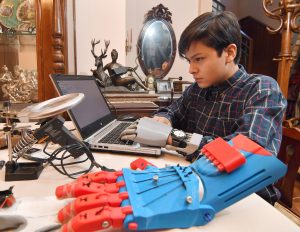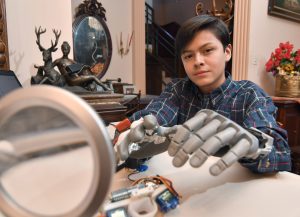
By Irene Escudero
La Paz, Mar 18 (EFE).- A little Bolivian boy discovered technology by chance when he broke a toy car and now, with a mixture of curiosity, passion and hard work, has succeeded in building his own robotic hand with a 3D printer.
“I threw a rock and broke the car” and saw all the pieces it was made of, the precocious 14-year-old Leonardo Viscarra told EFE, adding that he was 8 when that incident revealed the technology of assembly to him, and that was the springboard to his later achievements.
When he was in his mother’s womb, his right hand was caught in the placenta and was unable to develop. He was diagnosed with amniotic band syndrome.
The thermoplastic hand he wears today works with nylon strings that pick up the movements of his wrist and transmit them to fingers which, he admits, are unable to close completely.
It’s not perfect, but with it he can “hold a glass or bottle…a variety of objects that I could not hold before.”
He began by making a very weak artificial hand, a kind of pincers that at least allowed him to grab things. Later he made a more mechanized version, but it didn’t fit him at all well.
Doing some research, he said, he learned about a French boy wo was the first to have a prosthesis of this kind, then found out about a US foundation that manufactured them.

With the help of an aunt living in the United States, Viscarra contacted the firm and they sent him a first robotic hand, though it was too big and didn’t do him much good.
He didn’t give up. He was inspired by that prosthesis “to make another.” This time he put it together by himself to his exact measurements.
When he had the design, he went to the Sawers Robotics Institute in the central Bolivian city of Cochabamba, and there they helped him make it real.
With a 3D printer they printed practically the entire new hand, and with the help of his teachers and parents, Viscarra assembled all the pieces and held them together with nylon threads and cords.
Leonardo Viscarra got his robotic hand for less than $100, he said, whereas bionic prostheses on the market can cost $15,000.
The youth said he got the chance try out one of those hands when he was in the eastern city of Santa Cruz, a model with sensors connected to the hand muscles and which reacted to their movements with great precision.
If any youngsters were to ask his advice, he would recommend models different from the one he uses every day, because his homemade prototype doesn’t yet have the precision and strength he would like.
But this is just the start of his career, which will undoubtedly be driven by his passion for inventing, creating and doing research.
His teachers at school tell him he shouldn’t stop now but should dedicate himself to science and that he will achieve great things.
His classmates also try to help him and give him ideas for new inventions.
“I’d love to study biomedicine because it’s a profession that interests me and by making robotic prostheses, I’m already into it,” the young genius said.
